In this lesson we learned that expressions can be both numerical and with unknown. We checked several expressions. These were the simplest ones.
Now we can move on and look at more complex expressions. In this lesson, we will learn the order of operations.
Expressions can consist of several numbers. This are, for example, the following expressions:
10 − 1 + 2 + 3
(3 + 5) + 2 × 3
5 × 2 + (5 − 3) : 2 + 1
Such expressions cannot be calculated at once. It means that you cannot put an equal sign and write down the value of the expression. And they don't look as simple as 2 + 2 or 9 - 3.
For such expressions, it is important to follow the order of operations. The idea is that the expression is calculated by parts in a certain order.
When we need to solve such examples, we must immediately mentally read the following rule:
First calculate what is in parentheses!
Let's look at the expression 10 - 1 + 2 + 3. We see that it does not contain any parentheses. Then we go to the next rule, which looks like this:
Read the expression from left to right. If multiplication or division is found, do it right away!
Read our expression 10 - 1 + 2 + 3 from left to right. We see that there is no multiplication or division. Then we go to the next rule:
Read the expression from left to right. If an addition or subtraction is found, perform that operation immediately!
Read our expression 10 - 1 + 2 + 3 from left to right. We see the subtraction 10 - 1. You should immediately perform this operation: 10 − 1 = 9. Write the result (nine) in the main expression instead of 10 - 1
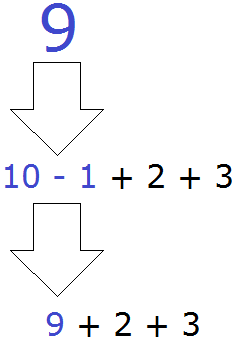
Then read again the rules that we read above. Read them in the following order:
1. First calculate what is in parentheses!
2. Read the expression from left to right. If multiplication or division is found, we apply that operation right away!
3. Read the expression from left to right. If an addition or subtraction is found, apply that operation immediately!
Now we have an expression 9 + 2 + 3 Read it from left to right and see the addition of 9 + 2. Perform this operation: 9 + 2 = 11. Write the number 11 in the main expression instead of 9 + 2:

That results to the simplest expression 11 + 3, which is easy to calculate:
11 + 3 = 14
Thus, the value of the expression 10 - 1 + 2 + 3 is 14
10 − 1 + 2 + 3 = 14
Sometimes it is convenient to arrange the order of operations over the expression itself. To do this, specify its order above the operation to be performed. For example, in the expression 10 - 1 + 2 + 3 all operations are performed sequentially from left to right, so the following order can be specified for it:

And then you can perform the actions individually, which is very convenient:
1) 10 − 1 = 9
2) 9 + 2 = 11
3) 11 + 3 = 14
Also, you can put an equal sign and immediately start calculating the expression following the rule above. For example, the solution to the expression 10 - 1 + 2 + 3 can be written as follows:

If person didn't learn to count quickly in his head, it is not recommended to use this method.
Example 2. Calculate (3 + 5) + 2 × 3
Let's apply the rules of the order of actions. Read the rules in order of priority.
First calculate what is in parentheses!
Let's look at the expression (3 + 5) + 2 × 3. We see that it contains an expression in parentheses (3 + 5). Let's calculate what is in those parentheses: 3 + 5 = 8. Write the resulting eight in the main expression instead of the bracketed expression:
8 + 2 × 3
Read the first rule again:
First, calculate what is in parentheses!
We see that the expression 8 + 2 × 3 does not contain any parentheses. Then we read the following rule:
Read the expression from left to right. If multiplication or division is found, we immediately perform this operation!
Let's look at our expression 8 + 2 × 3. We see that it has multiplication 2 × 3. Let's perform this operation: 2 × 3 = 6. Write the resulting 6 in the main expression instead of 2 × 3
8 + 6
That leaves the simplest expression 8 + 6, which is easy to calculate:
8 + 6 = 14
Thus, the value of the expression (3 + 5) + 2 × 3 is 14
(3 + 5) + 2 × 3 = 14
Also, this example can be solved by arranging the order of actions over the expression itself. The action in parentheses would be the first action, multiplication would be the second action, and the sum would be the third action:

And then you can perform the actions individually, which is very convenient:
1) 3 + 5 = 8
2) 2 × 3 = 6
3) 8 + 6 = 14
Also, you can put an equal sign and immediately start calculating the expression in order of priority of actions:

But again, using this method, you have to be very careful.
Example 3. Find the value of the expression 5 × 2 + (5 - 3) : 2 + 1
Let's arrange the order of actions over the expression. The action in parentheses will be the first action, multiplication will be the second action, division will be the third action, the fourth and fifth actions are sums and they will be performed in order:

1) 5 − 3 = 2
2) 5 × 2 = 10
3) 2 : 2 = 1
4) 10 + 1 = 11
5) 11 + 1 = 12
Also, you can put an equal sign and immediately start calculating the expression in order of priority of actions:

The fourth and fifth steps were to calculate the remaining simplest expression 10 + 1 + 1. We did not take the time to perform each of these steps, but put an equal sign and wrote down the answer 12.
Example 4. Calculate (3250 − 2905) : 5
Arrange the order of actions over the expression. The action in parentheses will be the first action, and division will be the second

1) 3250 − 2905 = 345
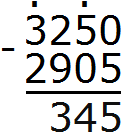
2) 345 : 5 = 69
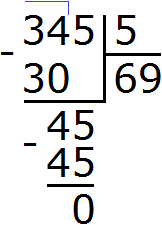
Two or more actions can be performed in parentheses. It even happens that there are other parentheses in the parentheses. In such cases, you should apply the same rules that we studied earlier.
Example 5. Find the value of the expression (6 411 × 8 − 40799) × 6
Arrange the order of actions over the expression. The action in parentheses will be the first action. The parentheses perform multiplication and subtraction. According to the order of actions, multiplication is performed before subtraction.
In this case, first multiply 6,411 by 8, and subtract 40,799 from the result. The result will be the value of the expression in parentheses. This result will be multiplied by 6.
The result will be the following order:

1) 6 411 × 8 = 51 288
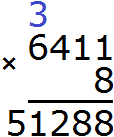
2) 51 288 − 40 799 = 10 489

3) 10 489 × 6 = 62 934

Example 6. Calculate: 1 657 974 : 822 × 106 − (50 377 + 20 338)
Arrange the order of actions over the expression. The action in parentheses is the first action, division is the second action, multiplication is the third, and subtraction is the fourth.

1) 50 377 + 20 338 = 70 715
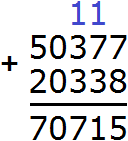
2) 1 657 974 : 822 = 2 017
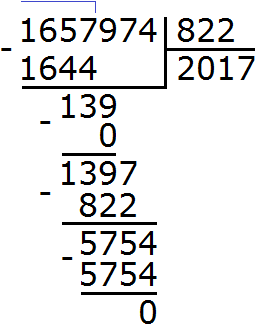
3) 2 017 × 106 = 213 802

4) 213 802−70 715 = 143 087
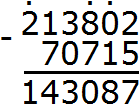
Example 7. Find the value of the expression: 14 026 − (96 : 4 + 3680)
Arrange the order of actions over the expression. The action in parentheses will be the first action. At the same time, division and addition are performed in parentheses. According to the order of actions, division is performed before addition.
In this case, you must first divide 96 by 4, and add the result to 3,680. The result will be the value of the expression in parentheses. This result must be subtracted from 14,026. The result will be in the following order:

1) 96 : 4 = 24

2) 24 + 3 680 = 3 704

3) 14026 − 3 704 = 10 322

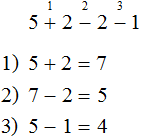
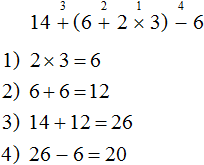
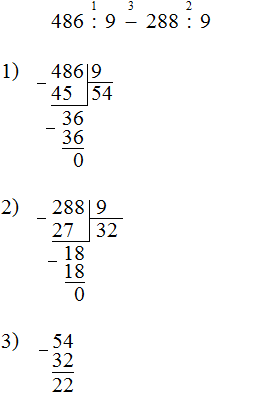


Comments
It is a wonderful pleasure , humbling experience to finally find a site that we, my daughter and i can truly trust,find effectively working to progress in an organize matter ,we are very excited to follow through the whole program.
We are far away, in South America originally from California, going back to the usa in the near future , my daughter is 17 yrs, old and yes home schooling the private schools way too expensive and public are pretty bad. we really like people that come across just humbling simple as yourself, i like that, equals POWER POWERFUL I would say that is really America so thank you very much for taking the time to put this great program together
thank you
Carla and Giuliana.